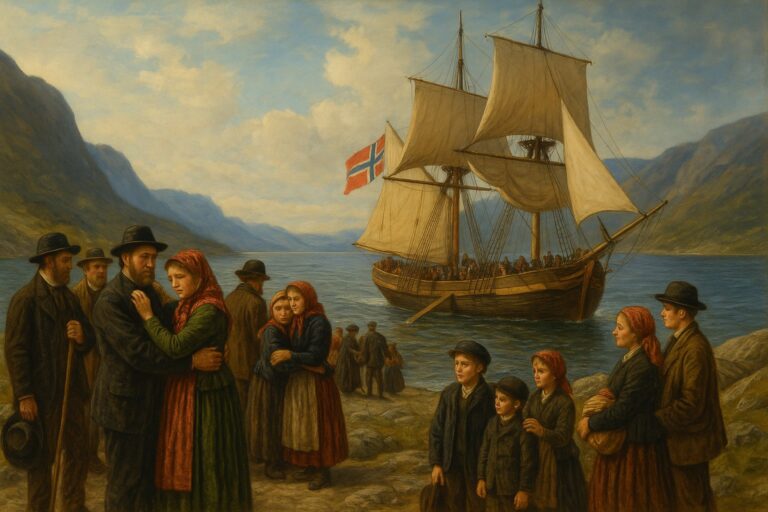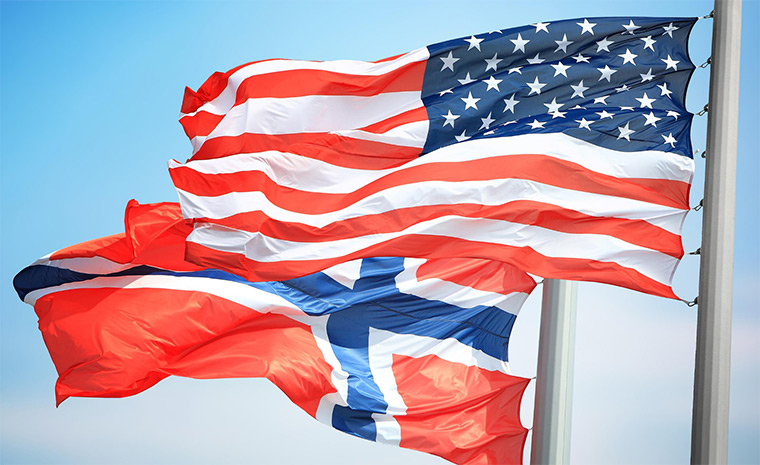In the 19th century, Norway saw one of the highest rates of emigration in Europe. For more than a hundred years, tens of thousands of Norwegians packed up their lives and sailed across the Atlantic, in search of opportunity.
On a summer day in 1825, a small sloop named Restauration set sail from Stavanger, bound for New York. On board were 52 Norwegians, many of them Quakers and Haugean Lutherans, seeking religious freedom and the promise of a new beginning.

Their arrival in America that autumn marked the beginning of a mass movement that would see nearly 900,000 Norwegians follow in their wake over the next century. For a country that today has a population of just over five million, this movement was nothing short of transformative.
Now, 200 years later, both Norway and the United States are commemorating this extraordinary journey. From exhibitions and festivals to a planned replica voyage retracing the Restauration’s route, 2025 has become a year of reflection.
It is a time to look back not only on the hardships and hopes of those early emigrants, but also on the lasting cultural connections they helped forge between two nations.
This is the story of what drove so many to leave, where they went, and how their legacy continues to shape lives on both sides of the Atlantic.
Why Did So Many Norwegians Leave?
The driving forces behind Norwegian emigration were varied, but they shared one common thread: the promise of something better.
Life in rural Norway during the 19th century could be harsh. Land was limited, especially in the mountainous west, and inheritance customs often left younger siblings with few prospects. As the population grew, competition for resources intensified, pushing many families into poverty.
Industrialisation arrived late in Norway, meaning urban jobs were limited and farming remained the dominant way of life.
In many regions, especially in areas like Sogn og Fjordane and Møre og Romsdal, subsistence farming was the norm, and crop failures or harsh winters could quickly spell disaster.
Religious motivation also played a part. Some Norwegians, particularly members of dissenting Christian movements like the Haugeans, sought greater freedom to practise their faith without interference from the state church.

Another powerful factor was the influence of “America letters.” These letters, sent by earlier emigrants, described a land of abundance, affordable farmland, and personal freedom.
Often read aloud in village gatherings, they painted a picture of America as a land of milk and honey. Whether or not these descriptions were fully accurate, they were incredibly persuasive.
The Long Journey Across the Atlantic
Early emigrants set sail on small wooden sailing ships from ports such as Bergen and Trondheim. These voyages could take several weeks, sometimes longer, and conditions on board were often grim.
Travellers endured cramped, unsanitary quarters and subsisted on limited food. Disease was a constant threat, particularly on the early crossings.
By the late 19th century, steamships had replaced sailing vessels, dramatically reducing the journey time. Most Norwegians travelled via European ports such as Hamburg or Liverpool, connecting to transatlantic liners bound for New York.
Ellis Island, which opened in 1892, processed the majority of Norwegian immigrants who arrived during the peak migration years.
Despite the hardships of the journey, for many it was a one-way ticket. They left their homes and families behind, often knowing they would never return.
A New Life in the Midwest
Although Norwegians settled in a variety of places, the American Midwest became their heartland.
States such as Minnesota, Wisconsin, Iowa, Illinois, and North Dakota welcomed large numbers of Norwegian immigrants, many of whom sought farmland that reminded them of home.
They established small rural communities where Norwegian language, customs, and religion continued to play a central role. Lutheran churches, folk music, and even traditional foods helped sustain a sense of identity in a new world.

In these enclaves, Norwegian was spoken for generations, and local newspapers were printed in both Norwegian and English. Today, the Norwegian American remains an important mouthpiece for the communities.
Over time, many Norwegians found work beyond the farm. They contributed to the growing railway system, worked in logging camps, or took jobs in the cities.
Wherever they went, they brought with them a strong sense of community, a love of education, and a determination to succeed.
The Impact on Norway
The effects of emigration were felt deeply in Norway. On one hand, it provided relief in overpopulated rural areas. With fewer mouths to feed and less pressure on farmland, those who remained had a better chance of survival.
Some families even viewed emigration as a form of family investment, pooling resources to send one or two members abroad.
On the other hand, entire communities were hollowed out. Young people in particular were drawn to the promise of a better life, leaving behind ageing populations and weakened local economies. Emigration also sparked political debate in Norway about inequality, opportunity, and the need for reform.
A significant number of Norwegians eventually returned home, bringing with them new ideas, savings, and in some cases, American spouses. These returnees contributed to social change, often encouraging more progressive attitudes and fostering transatlantic connections that lasted for decades.
A Shared Legacy
Today, the legacy of Norwegian emigration can still be felt on both sides of the Atlantic. In the United States, millions of Americans claim Norwegian ancestry.
Norwegian-American communities maintain strong cultural traditions and celebrate events such as Norwegian Constitution Day on 17 May with parades, folk costumes, and music.
Meanwhile in Norway, the emigration story is remembered with both pride and nostalgia. It is a reminder of the resilience and courage of ordinary people who crossed an ocean to build new lives.
Norwegian-American Communities Today
Two centuries after the first emigrants left Norway, their legacy is still very much alive in the communities they helped build. Across the United States, a vibrant network of clubs, societies, and cultural institutions continues to celebrate Norwegian heritage and keep the transatlantic connection thriving.
The city of Decorah, Iowa, is home to the Vesterheim Norwegian-American Museum, which preserves the stories of emigrants and their descendants. Across the Midwest, Norwegian festivals, museums, and heritage centres continue to educate new generations about their roots.

One of the most visible organisations is the Sons of Norway, founded in 1895 to promote and preserve Norwegian culture among descendants of immigrants.
With lodges across the United States, Canada, and even Norway, the organisation offers language courses, cultural events, heritage camps for young people, and support for genealogical research. It also publishes a long-running magazine filled with stories, recipes, and news from both sides of the ocean.
In Minneapolis, Norway House has emerged as a leading centre for Norwegian-American culture and cooperation.
Located just a short walk from the Norwegian Lutheran Memorial Church, Norway House hosts art exhibitions, lectures, language classes, and business conferences. It serves as a hub for both cultural exploration and modern exchange.
Other institutions, such as the National Nordic Museum in Seattle, provide physical spaces where the emigrant story is preserved and shared with new generations.
From small-town 17 May parades to folk-dancing groups and lutefisk dinners, these organisations help maintain a cultural identity that spans oceans.
For many descendants of Norwegian immigrants, involvement in these societies is not just about honouring the past, but also about building community and understanding where they come from.
Marking 200 Years of Emigration
The year 2025 marks two centuries since the Restauration set sail from Stavanger, carrying the first organised group of Norwegian emigrants to America. To commemorate this milestone, a range of events and initiatives are taking place in both Norway and the U.S. throughout the year.
In Norway, the city of Stavanger is at the heart of the celebrations, with exhibitions, lectures, and cultural programmes honouring the legacy of the emigrants.
A centrepiece of the anniversary is a planned replica voyage of the Restauration, which will retrace the original 1825 journey across the Atlantic. The project aims to bring history to life while fostering renewed connections between descendants of emigrants and their ancestral homeland.
Across the Atlantic, the Vesterheim Norwegian-American Museum in Decorah, Iowa, hosts a year-long exhibition. Titled 200 Years of Norwegians in America, it explores the emigrant experience through personal stories, artefacts, and artistic interpretations.
Other Norwegian-American institutions are also marking the anniversary with local events, festivals, and genealogy workshops.
The bicentenary is more than a celebration of the past. It offers an opportunity to reflect on the themes of migration, identity, and belonging that remain deeply relevant today.
As families on both sides of the Atlantic revisit the stories of their ancestors, the anniversary serves as a powerful reminder of how a small ship from Stavanger helped build enduring cultural ties that continue to shape lives two hundred years later.


* DON’T FOR FORGET THE SAILORS AND SEAPORTS!
My family came to pensacola, florida about 1890ish from Stravanger-
as merchant mariners, they hauled southern longleaf yellow pine back to the motherland. If you research some of the buildings you will find many were made with what was called ‘yellow gold’, for the southern U.S. was known yellow pine that was strong and the resin was of great value.
also for
NAVAL LIVE OAK THAT WAS EXCELLANT FOR SHAPING THE HULLS OF MANY ships.
850 206 7696
HAROLD HOMMELAND
Six of my eight great-grandparents came from Norway between 1864 and 1891. One came from Oppland, three came from Hedmark, one came from Akershus, and one from Nord-Trøndelag. The other two great-grandparents were born here to Norwegian parents who had arrived in the mid-1850s. All lived in Minnesota, and all but one died and are buried in Minnesota. Some homesteaded, but most gravitated towards Minneapolis and St. Paul.